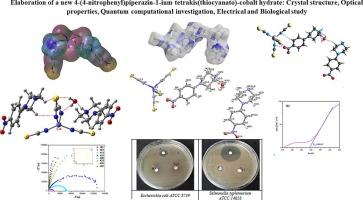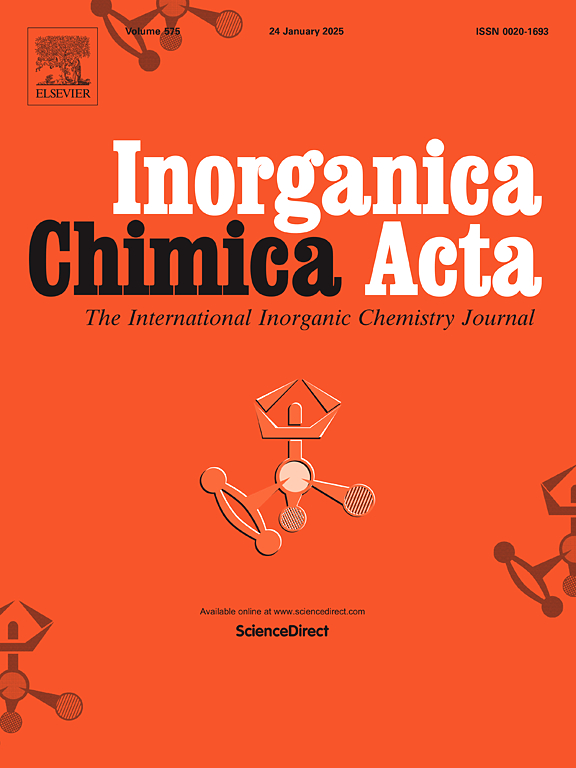一种新的 4-(4-硝基苯基)哌嗪-1-鎓四(硫氰酸根)钴水合物的制备:晶体结构、光学特性、量子计算研究、电学和生物学研究
IF 2.7
3区 化学
Q2 CHEMISTRY, INORGANIC & NUCLEAR
引用次数: 0
摘要
报告了一种新型三维化合物 (C10H14N3O2)2 [Co(NCS)4].H2O ((NPP)2[Co(NCS)4].H2O)的制备、光谱、生物和电学表征以及 X 射线晶体结构研究。合成的化合物在 Pna21 空间群中结晶。其结构包括由硫氰酸盐-N 配体桥接的钴 (II) 层,在金属中心周围形成扭曲的 MN4 四面体。我们利用傅立叶变换红外光谱测量法研究了官能团的振动模式。Hirshfeld 表面(HS)分析和电子结构计算揭示了稳定复合物的出色反应性和分子间相互作用。此外,还使用 DFT 方法计算了变化传递和 NLO 参数。对光学行为的研究表明,该复合物具有很高的光学特性。对 (NPP)2[Co(NCS)4].H2O进行的阻抗光谱研究发现了其迷人的电学行为,这表明在特定条件下,Co 复合物成分可用作电子芯片。热分析证实了晶体的热稳定性。该化合物的抗菌活性表明,钴复合物对不同类型的细菌具有抑制作用。本文章由计算机程序翻译,如有差异,请以英文原文为准。

Elaboration of a new 4-(4-nitrophenyl)piperazin-1-ium tetrakis(thiocyanato)-cobalt hydrate: Crystal structure, optical properties, quantum computational investigation, electrical and biological study
The preparation, spectroscopic, biological, and electrical characterization, in addition to the X-ray crystal structure investigation of a novel three-dimensional compound (C10H14N3O2)2 [Co(NCS)4].H2O ((NPP)2[Co(NCS)4].H2O) is reported. The synthesized compound crystallizes in the Pna21 space group. The structure comprises layers of cobalt (II) bridged by terminally bound thiocyanate-N ligand achieving distorted MN4 tetrahedron surroundings around the metal center. The vibrational modes of the functional groups were investigated using FT-IR measurements. Hirshfeld surface (HS) analysis and electronic structures calculations reveal the excellent reactivity and intermolecular interactions in stabilizing complex. The change transfer and NLO parameters were also computed using the DFT method. The study of the optical behavior reveals a high optical property. Explorations of impedance spectroscopy on (NPP)2[Co(NCS)4].H2O reveals fascinating electrical behavior which reveals that the Co complex component can be used as an electronic chip under certain conditions. The thermal analysis was used to confirm the crystal’s thermal stability. The compound’s antimicrobial activity suggested that the Cobalt complex acts as an inhibitor Agent against different types of bacteria.
求助全文
通过发布文献求助,成功后即可免费获取论文全文。
去求助
来源期刊

Inorganica Chimica Acta
化学-无机化学与核化学
CiteScore
6.00
自引率
3.60%
发文量
440
审稿时长
35 days
期刊介绍:
Inorganica Chimica Acta is an established international forum for all aspects of advanced Inorganic Chemistry. Original papers of high scientific level and interest are published in the form of Articles and Reviews.
Topics covered include:
• chemistry of the main group elements and the d- and f-block metals, including the synthesis, characterization and reactivity of coordination, organometallic, biomimetic, supramolecular coordination compounds, including associated computational studies;
• synthesis, physico-chemical properties, applications of molecule-based nano-scaled clusters and nanomaterials designed using the principles of coordination chemistry, as well as coordination polymers (CPs), metal-organic frameworks (MOFs), metal-organic polyhedra (MPOs);
• reaction mechanisms and physico-chemical investigations computational studies of metalloenzymes and their models;
• applications of inorganic compounds, metallodrugs and molecule-based materials.
Papers composed primarily of structural reports will typically not be considered for publication.
 求助内容:
求助内容: 应助结果提醒方式:
应助结果提醒方式:


